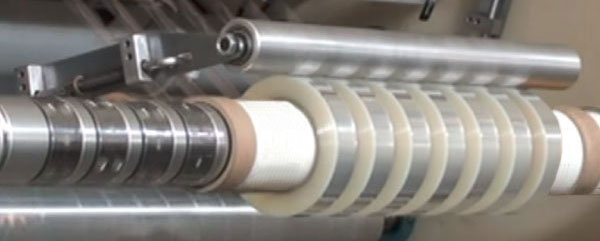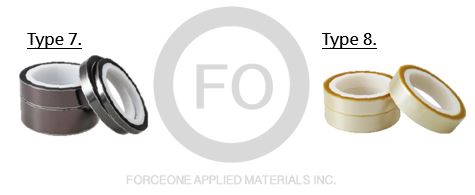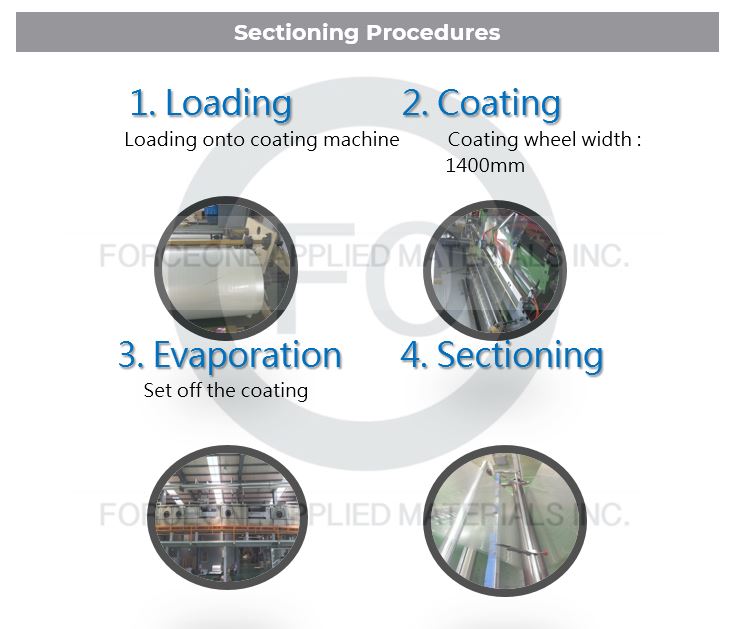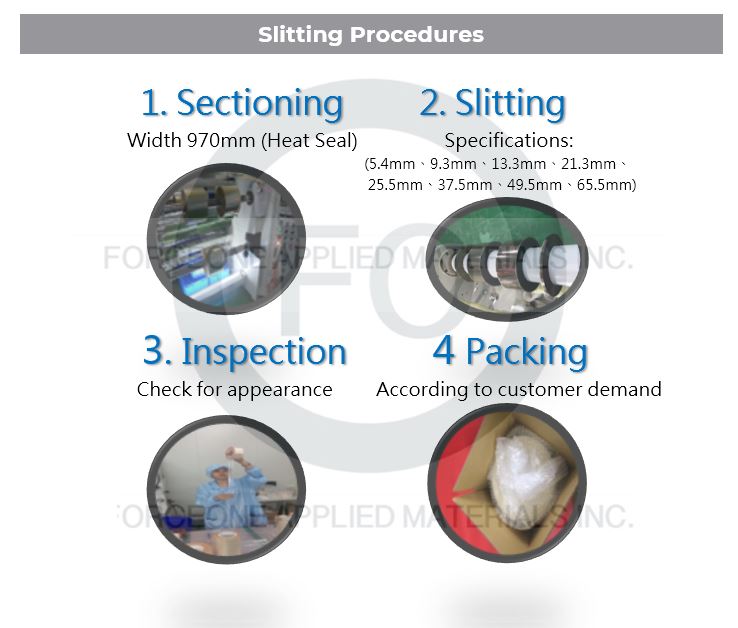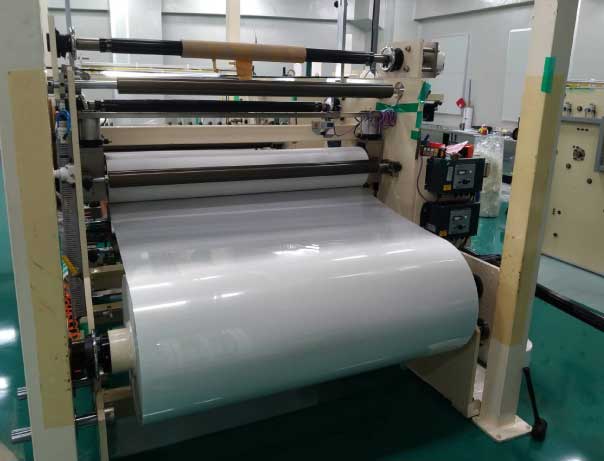Application for Pressure Sensitive Adhesives Cover Tape
Force-One is a manufacturer of optical film in "Taiwan". We fit requirement of America semiconductor.
Force-One's cover tape have very stable peeling strength for PS or PC carrier tape as below.
Our anti high temporature cover tape can stock at 60 degree C from 0day to 60days, the peeling strength is still very stable.
1.If you need ship at high temporature by truck or seashipment.
2.If your stock or warehouse have the risk of high temporature
3.If you have issue with unstable peeling strenght (force) or components jumping
4.If you need Automated optical inspection (AOI) to check your elements. Our cover tape is very clear at AOI system.
You can use our anti high temporature cover tape to make sure the peeling force is always stable.
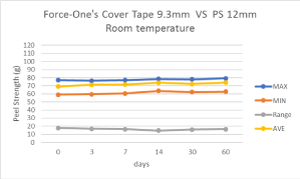
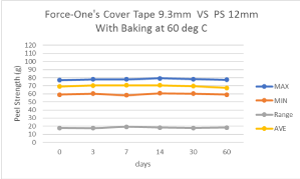
How many size of anti-static PSA Cover Tape (Normal Type)?
Width: 5.4mm, 9.3mm, 13.3mm, 21.3mm, 25.5mm, 37.5mm, 49.5mm, 65.5mm, 81.5mm
What kind size of cover tape need go with difference width carrier tape like 8 mm, 12 mm, 16 mm, and 24 mm...?
1. Carrier Tape of 8 mm has to be used with Cover tape of 5.4mm.
2. Carrier Tape of 12 mm has to be used with Cover tape of 9.3mm.
3. Carrier Tape of 16 mm has to be used with Cover tape of 13.3mm.
4. Carrier Tape of 24 mm has to be used with Cover tape of 21.3mm.
5. Carrier Tape of 32 mm has to be used with Cover tape of 25.5mm.
6. Carrier Tape of 44 mm has to be used with Cover tape of 37.5mm.
7. Carrier Tape of 56 mm has to be used with Cover tape of 49.5mm.
8. Carrier Tape of 72 mm has to be used with Cover tape of 65.5mm.
9. Carrier Tape of 88 mm has to be used with Cover tape of 81.3mm.
PSA Cover Tape(Heat-Resisting Type)
The Benefits:
1.PET with Pressure Sensitive Adhesives combined with brown or Transparent anti-static film.
2.Excellent and stable quality . The aging (60℃ / 720hrs) and peeling force test had passed.
3.The value of anti-static is 10^9~10^11, Adhesive is 10^8~10 It can prevent ESD issue.
4.Excellent sealing. Can meet any carrier tape of PC, PS, PET to seal.
5.Thickness: 60 ± 5 um. Can anti high temperatures before vacuum packaging (120℃) without peeling issue.
Want to know more, Welcome to Contact us
Read About "Sealing Heat Cover Tape"
>Cutting Line:
===The Introduction of Force-One's Cover Tape===
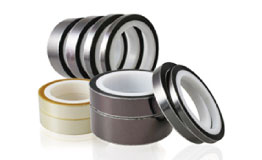
Force-One's is uniquely designed to peel through the film itself and available as static dissipative.The cover tapes for semiconductor(IC) or Passive components seal electrical and electronic components into Carrier Tapes, it have anti-static layers can anti-static(ESD) during packing, transport and storage. The cover tapes for semiconductor could combine excellent sealing properties with smooth peel force to protect IC or Passive components and permit efficient pick-and-place operations. The full line of Force-One's Cover Tapes includes conductive, non-conductive and static dissipative products with heat activated or pressure-sensitive adhesive.
Both PSA and HAA cover tapes can be found in non-conductive and static-dissipative versions. Some cover tapes are termed anti-static which are usually perceived as being the same as static-dissipative cover tapes. Technically, anti-static refers to a material which does not generate a static charge when rubbed against a second material (triboelectric charging). Static dissipative refers to a material which can bleed off a charge through the mechanism which provides it’s surface resistivity. A non-conductive material is defined as having a surface resistivity (Rs) greater than 10^12 ohms/square. Static dissipative material is defined as having a surface resistivity (Rs) between 10^5 ohms/square and 10^12 ohms/square. While conductive material is defined as having a surface resistivity (Rs) of less than 10^5 ohms/square.
The cover tapes(Tape & Reel) for semiconductor(IC) or Passive components is good for SMD/SMT(Surface-Mount Device / Surface-Mount Technology) process. And can anti-static cover tape for packaging of surface mount devices (ESD protection).
Common TDS: Thin:0.05~0.06 mm ; Transmittance: 60%~89% ; Haze: 3%~30% ; Anti-static: ≦10^9-11Ω/sq ; Working temperature:140℃ - 190℃ ; RA pass:55℃~60℃/720 hrs
Width: 5.4mm, 9.3mm, 13.3mm, 21.3mm, 25.5mm, 37.5mm, 49.5mm, 65.5mm, 81.5mm
◆Heat Activated (HAA)
1. Normal Type
2. Transparent Type
3. Conductive Type
Read More About "Heat Activated Cover Tape"◆Pressure Sensitive Adhesives Sensitive (PSAs)
1. Normal Type
2. Conductive Type
3. Heat-Resisting Type
Read More About "PSA Cover Tape"Want to know more, Welcome to Contact us
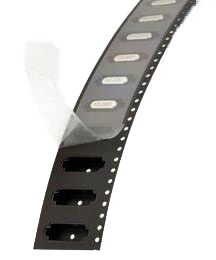
*****Sealing Heat Activated Cover Tape*****
For any heat-activated adhesive cover tape, as a general rule,increasing temperature, dwell time, and pressure on a given sealing machine will, within limits, increase adhesion (peel). However, for most of the HAA cover tapes available in the marketplace today, temperature and dwell will have a greater affect on adhesion than pressure. The ways these variables interact in the sealing process are of interest to anyone trying to control a packaging process.
>Normal Type Cover Tape
Similar as Common TDS
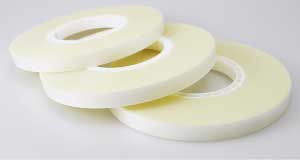
>Transparent Type Cover Tape
Special TDS: Transmittance: 89%
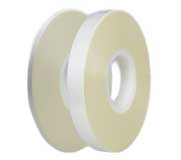
>Conductive Type Cover Tape
Special TDS: PET's anti-static: ≦10^5-10Ω/sq ; Adhesive anti-static: ≦10^9Ω/sq
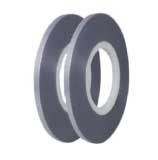
*****Pressure Sensitive Adhesives Cover Tape*****
PSA cover tapes require different processing and handling than heat activated cover tapes and are generally considered to be easier to seal than their heat activated counterparts. The PSA adhesive is a synthetic adhesive formulated to remain tacky over a wide range of temperatures, including room temperature. Hence, PSA cover tapes require no heat to seal them to the carrier. To prevent components from sticking to the adhesive, a liner film is added to cover the adhesive in the center portion of the cover tape. PSA cover tapes are slightly more complex in their cons
>Normal Type-Cover Tape
Similar as Common TDS
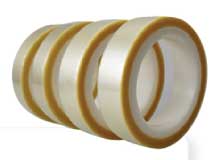
>Conductive Type Cover Tape
Special TDS: Adhesive anti-static:≦10^3-5Ω/sq
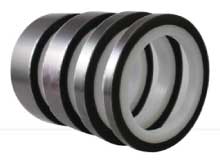
>Heat-Resisting Type Cover Tape
Special TDS: Can Heat-Resisting: 125℃/8hr or 50℃/24hr
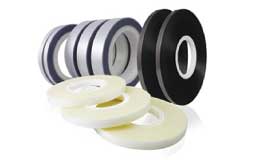
Want to know more, Welcome to Contact us
==========================
About Cover Tape
Cover tape still can call: tape and reel, tape reel, SMD package, semiconductor tape, reel to reel, SMD reels, reel to reel tape, tape and reel packaging, electric reel, tape & reel packagin , 2668 , 2698 , 2671A for semiconductor packaging, component packaging
Cover tape combine with carrier tape and use for package the semiconductor(IC) or Passive components seal electrical and electronic components, it have anti-static layers can anti-static(ESD) during packing, transport and storage. Both PSA and HAA cover tapes can be found in nonconductive and static-dissipative versions. Some cover tapes are termed anti-static which are usually perceived as being the same as static-dissipative cover tapes. Technically, antistatic refers to a material which does not generate a static charge when rubbed against a second material (triboelectric charging). Static dissipative refers to a material which can bleed off a charge through the mechanism which provides it’s surface resistivity.
When sealing an HAA cover tape, temperature refers to the indicated temperature of the sealing mechanism. Heat activated adhesives are dry to the touch at room temperature. The absence of any tackiness is the property that permits their ready handling under these conditions. Tackiness must be attained to get the adhesive to “stick” the cover tape to the carrier tape. To accomplish this, energy in the form of heat is used to “activate” the cover tape’s adhesive system. This activation is the process that raises the temperature of the adhesive until it achieves a level of tackiness which allows it to adhere to the carrier tape. But PSA cover tapes require different processing and handling than heat activated cover tapes and are generally considered to be easier to seal than their heat activated counterparts. The PSA adhesive is a synthetic adhesive formulated to remain tacky over a wide range of temperatures, including room temperature. Hence, PSA cover tapes require no heat to seal them to the carrier. To prevent components from sticking to the adhesive, a liner film is added to cover the adhesive in the center portion of the cover tape.
REFERENCES:FUNDAMENTALS OF PSA AND HEAT ACTIVATED COVER TAPE SEALING FOR COMPONENTS PACKAGED IN TAPE AND REEL
2668 , 2698 , 2671A
==Process Introduction==
>Coating Line:
>Cutting Line:
===The Introduction of Force-One's Cover Tape===

Force-One's is uniquely designed to peel through the film itself and available as static dissipative.The cover tapes for semiconductor(IC) or Passive components seal electrical and electronic components into Carrier Tapes, it have anti-static layers can anti-static(ESD) during packing, transport and storage. The cover tapes for semiconductor could combine excellent sealing properties with smooth peel force to protect IC or Passive components and permit efficient pick-and-place operations. The full line of Force-One's Cover Tapes includes conductive, non-conductive and static dissipative products with heat activated or pressure-sensitive adhesive.
Both PSA and HAA cover tapes can be found in non-conductive and static-dissipative versions. Some cover tapes are termed anti-static which are usually perceived as being the same as static-dissipative cover tapes. Technically, anti-static refers to a material which does not generate a static charge when rubbed against a second material (triboelectric charging). Static dissipative refers to a material which can bleed off a charge through the mechanism which provides it’s surface resistivity. A non-conductive material is defined as having a surface resistivity (Rs) greater than 10^12 ohms/square. Static dissipative material is defined as having a surface resistivity (Rs) between 10^5 ohms/square and 10^12 ohms/square. While conductive material is defined as having a surface resistivity (Rs) of less than 10^5 ohms/square.
The cover tapes(Tape & Reel) for semiconductor(IC) or Passive components is good for SMD/SMT(Surface-Mount Device / Surface-Mount Technology) process. And can anti-static cover tape for packaging of surface mount devices (ESD protection).
Common trS: Thin:0.05~0.06 mm ; Transmittance: 60%~89% ; Haze: 3%~30% ; Anti-static: ≦10^9-11Ω/sq ; Working temperature:140℃ - 190℃ ; RA pass:55℃~60℃/720 hrs
Width: 5.4mm, 9.3mm, 13.3mm, 21.3mm, 25.5mm, 37.5mm, 49.5mm, 65.5mm, 81.5mm
What kind size of cover tape need go with difference width carrier tape like 8 mm, 12 mm, 16 mm, and 24 mm...?
1. Carrier Tape of 8 mm has to be used with Cover tape of 5.4mm.
2. Carrier Tape of 12 mm has to be used with Cover tape of 9.3mm.
3. Carrier Tape of 16 mm has to be used with Cover tape of 13.3mm.
4. Carrier Tape of 24 mm has to be used with Cover tape of 21.3mm.
5. Carrier Tape of 32 mm has to be used with Cover tape of 25.5mm.
6. Carrier Tape of 44 mm has to be used with Cover tape of 37.5mm.
7. Carrier Tape of 56 mm has to be used with Cover tape of 49.5mm.
8. Carrier Tape of 72 mm has to be used with Cover tape of 65.5mm.
9. Carrier Tape of 88 mm has to be used with Cover tape of 81.3mm.
What difference about SMT, SMD, DIP?
SMT(SMT: surface Mount Technology)
SMD(SMD: surface Mount Device)
DIP(Dual In-line Package)
About Peeling Strength (pulling force) from EIA Standard-D
4.11 in EIA Standard-D:
The cover tape for each style and material of carrier tape shall have a total peel strength of from 0.1 N to 1.0 N (10 grams to 100 grams calibrated scale reading) for 8 mm carrier tapes and 0.1N to 1.3 N (10 grams to 130 grams calibrated scale reading) for 12 mm to 56 mm wide carrier tapes and from 0.1N to 1.5 N (10 grams to 150 grams calibrated scale reading) for 72 mm and wider carrier tapes. Peel is defined as the separation of the full width of the cover tape from the carrier tape or the removal of the center portion of the cover tape from the carrier tape to enable component removal from the cavity. The direction of pull shall be opposite the direction of carrier tape travel such that the cover tape makes an angle of between 165 and 180 degrees with the top of the carrier tape. The cover tape, shall be pulled with a velocity of 300 mm±10 mm/minute, relative to the carrier tape, during peeling, which results in the cover/carrier tape seal being separated at a rate of 150 mm/minute.
How much Peeling Strength (pulling force) can fit you? From EIA Standard-D
1. 0.1 N to 1.0 N (10 grams to 100 grams calibrated scale reading) for 8 mm carrier tapes.
2. 0.1 N to 1.3 N (10 grams to 130 grams calibrated scale reading) for 12 mm to 56 mm wide carrier tapes
3. 0.1N to 1.5 N (10 grams to 150 grams calibrated scale reading) for 72 mm and wider carrier tapes.
The pulling strength of our Heat-Seal, PSA cover tape is 20~90 gram, 40~130 gram, but it still difference pulling strength from difference carrier tape. We have stable pulling strength improve the component jump at SMD.
Surface-mount technology
Surface-mount technology (SMT) is a method in which the electrical components are mounted directly onto the surface of a printed circuit board (PCB). An electrical component mounted in this manner is referred to as a surface-mount device (SMD). In industry, this approach has largely replaced the through-hole technology construction method of fitting components, in large part because SMT allows for increased manufacturing automation. Both technologies can be used on the same board, with the through-hole technology often used for components not suitable for surface mounting such as large transformers and heat-sinked power semiconductors.
An SMT component is usually smaller than its through-hole counterpart because it has either smaller leads or no leads at all. It may have short pins or leads of various styles, flat contacts, a matrix of solder balls (BGAs), or terminations on the body of the component.
For Surface-mount technology (SMT), cover tape is very important. If the peeling strength is not stable, the component will jump out at SMT line. If the anti-static is not stable, the component will be broke by electrical static discharge.
Force-One's cover tapes have good quality can avoid any issue like jumping, ESD, particle. We can increase the ratio of utilization at your SMT.
About Cover Tape for SMT SMD, Hou many kind of cover tape type
Cover tape still can call: tape and reel, tape reel, SMD package, semiconductor tape, reel to reel, SMD reels, reel to reel tape, tape and reel packaging, electric reel, tape & reel packaging, 2668 , 2698 , 2671A for semiconductor packaging, component packaging
Cover tape combines with carrier tape and use for packageing the semiconductor(IC) or Passive components seal electrical and electronic components, it has anti-static layers can anti-static(ESD) during packing, transport and storage. Both PSA and HAA cover tapes can be found in nonconductive and static-dissipative versions. Some cover tapes are termed anti-static which are usually perceived as being the same as static-dissipative cover tapes. Technically, antistatic refers to a material that does not generate a static charge when rubbed against a second material (triboelectric charging). Static dissipative refers to a material that can bleed off a charge through the mechanism which provides it’s surface resistivity.
When sealing an HAA cover tape, temperature refers to the indicated temperature of the sealing mechanism. Heat-Activated adhesives are dry to the touch at room temperature. The absence of any tackiness is the property that permits their ready handling under these conditions. Tackiness must be attained to get the adhesive to “stick” the cover tape to the carrier tape. To accomplish this, energy in the form of heat is used to “activate” the cover tape’s adhesive system. This activation is the process that raises the temperature of the adhesive until it achieves a level of tackiness which allows it to adhere to the carrier tape. But PSA cover tapes require different processing and handling than Heat-Activated cover tapes and are generally considered to be easier to seal than their Heat-Activated counterparts. The PSA adhesive is a synthetic adhesive formulated to remain tacky over a wide range of temperatures, including room temperature. Hence, PSA cover tapes require no heat to seal them to the carrier. To prevent components from sticking to the adhesive, a liner film is added to cover the adhesive in the center portion of the cover tape.
The Cover Tapes
Cover tapes are used in electronics manufacturing, particularly in the assembly of surface-mount devices (SMDs) onto printed circuit boards (PCBs). These tapes serve as protective covers for the components during transportation, storage, and assembly processes.
The cover tape is typically a thin, flexible strip made of a polymer material such as polyester or polycarbonate. It features a strong adhesive on one side to securely attach to the carrier tape, which holds the SMD components in place. The cover tape is applied over the components, forming a protective barrier that prevents damage from dust, moisture, electrostatic discharge (ESD), and mechanical stresses.
During the assembly process, the cover tape is peeled off to expose the components, allowing automated pick-and-place machines to accurately position them onto the PCB. Once the components are placed, the cover tape is discarded.
Cover tapes come in various widths, thicknesses, and adhesive strengths to suit different types of components and assembly requirements. They are an essential component in the packaging and handling of SMDs, ensuring the integrity of the components from manufacturing to end use.
The Precautions of Cover Tapes
When using cover tapes in electronics manufacturing, several precautions should be taken to ensure the effectiveness of the tapes and the protection of the components:
Proper Storage: Store cover tapes in a controlled environment to prevent exposure to moisture, dust, or extreme temperatures, which could compromise their adhesive properties or structural integrity.
Avoid Static Buildup: Ensure that cover tapes are designed to minimize static electricity buildup, especially if they will be used in environments with sensitive electronic components. Antistatic cover tapes or packaging materials can help mitigate the risk of electrostatic discharge (ESD) damage.
Compatibility Check: Verify that the cover tape is compatible with the specific surface-mount components and assembly equipment being used. Compatibility issues can lead to adhesive failures, misfeeds, or other operational problems during the assembly process.
Proper Application: Apply cover tapes carefully and securely to the carrier tape to ensure proper adhesion and coverage of the components. Improper application can result in the tape peeling off prematurely, exposing the components to potential damage.
Avoid Contamination: Prevent contamination of the adhesive surface of the cover tape by handling it with clean hands or using gloves. Contaminants such as oils, dirt, or residues can affect the adhesion and performance of the tape.
Correct Removal Technique: When removing the cover tape to expose the components, peel it off slowly and carefully to minimize the risk of damaging the components or leaving adhesive residue behind. Follow manufacturer guidelines for the recommended removal technique.
Dispose Properly: Dispose of used cover tapes in accordance with local regulations and environmental guidelines. Consider recycling options for cover tapes to minimize waste generation and environmental impact.
Quality Assurance: Conduct regular quality checks on cover tapes to ensure they meet specifications and performance requirements. Inspect for defects such as tears, wrinkles, or adhesive inconsistencies that could affect their effectiveness.
By following these precautions, manufacturers can maximize the effectiveness of cover tapes in protecting surface-mount components during electronics assembly processes while minimizing the risk of damage or operational issues.
REFERENCES: FUNDAMENTALS OF PSA AND Heat-Activated COVER TAPE SEALING FOR COMPONENTS PACKAGED IN TAPE AND REEL
2668 , 2698 , 2671A
About Force-One
Force-One Applied Materials CO., LTD. is a professional optical film manufacturer. And have know how of formulas. We can meet different specifications for every customer with high quality. Our customers are all over the world including: America ,India , China, Taiwan, Malaysia, Philippines, Singapore, Thailand, Vietnam, Indonesia.

